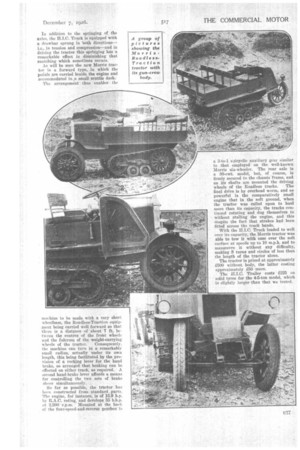A TRACTOR AND TRAILER ACROSS COUNTRY.
Page 62

Page 63

If you've noticed an error in this article please click here to report it so we can fix it.
IN view of the great interest which is now being taken in the develop .. mut of cross-country transport overseas and the numerous types of vehicle and tractor being built for this elass of work, our readers will appreciate the importance which must be attached to the question of making thorough tests not only of the vehicles and tractors themselves, but of the trailers which they are in some cases designed to draw.
One of these, which has already won for itself an extremely good name, both for reliability and easy running, is the H.I.C. Truck, designed in various models by Haulage Improvements and Constructions, Ltd., Granville House, Arundel Street, London, .W.C.2. This transport truck—we use the makers' own term—is already being employed in many parts of the world and 'by such concerns as the Elder Dempster Co. The model we actually saw tested is known as the E.D. type, being the same as employed by that company and built to carry 3-4-ton loads.
A most important feature of the H.I.C. Truck is its Means for suspension, this being so arranged by a combination of coil compression springs that shocks experienced by the wheels are not all 'resolved vertically,-as is the case with the ordinary form of springing, but are also taken up practically horizontally, so that in encountering an obstacle a wheel may tend to lag until the resistance of the springs causes it
to pass over. This constitutes what may be termed a gearing-down effect, somewhat resemblint that employed in an American vehicle which we described recently, and which, in that case, was termed a relay action.
It mighTot —lit. thought that the matter a suspension could have a marked effect upon. the tractive resistance of a trailer, but we have been informed by a representative of Road. less Traction, Ltd.' that in cases where the H.I.C. Truck has been substituted for certain other types of trailer of similar load capacity, difficult gradients and patches of rough country, which formerly caused tractors to stall, have been negotiated quite easily, proving that the springing certainly does exercise a groat influence. We can well believe this, as, during a run over the rough, sandy wastes, pock-marked with gullies, which constitute much of the surface of the Long Valley, Aldershot, we found that riding on a trailer proved quite comfortable so far as vibration was concerned ; even when crossing fairly deep gullies the movement of the trailer body was steady, with none of those hammering shocks which are so often experienced. This comfort was, of course, accentuated by the giant pneumatic tyres employed on the trailer, thus affording it a welldistributed pressure over the soft surface soaked by constant rain.
In addition to the springing of the axles, the H.I.C. Truck is equipped with a drawbar sprung in both directionsi.e., in tension and compression—and in driving the tractor this springing has a remarkable effect in diminishing that snatching which sometimes occurs.
As will be seen the new Morris tractor is a forward type, in which the pedals are carried beside the engine and accommodated in .a small scuttle dash.
The arrangement thus enables the machine to be made with a very short wheelbase, the Roadless-Traction equipment being carried well forward so that the.re is a distance of about 7 ft. between the centres of the front wheels and the fulcrum of the weight-carrying wheels of the tractor. Consequently, the machine can turn in a remarkably small radius, actually under its own length, this being facilitated by the provision of a rocking lever for the hand brake, so arranged that braking can be effected on either track, as required. A second hand-brake lever affords a means for controlling the two sets of brake shoes simultaneously.
So far as possible, the tractor has been constructed from standard parts. The engine, for instance, is of 15.9.h.p. by R.A.C. rating, and develops 35 b.h.p. at 2,200 r.p.m. Mounted at the back of the four-speed-and-reverse gearbox is
a 3-to-1 epicyclic auxiliary gear similar to that employed on the well-known Morris six-wheeler. The rear axle is a 30-cwt. model, but, of course, is firmly secured to the chassis frame, and on its shafts are mounted the driving wheels of the Roadless tracks. The final drive is by overhead worm, and so powerful is the comparatively small engine that in the soft ground, when the tractor was called upon to haul more than its capacity, the tracks continued rotating and dug themselves in without stalling the engine, and this despite the fact that strakes had been fitted across the track bands.
With the Truck loaded to well aver its capacity, the Morris tractor was able to tow it with ease over the soft surface at speeds up to 10 m.p.h. and to manoeuvre . it without any difficulty, making S turns and circles of less than the length of the tractor alone. The tractor is priced at approximately £500 without body, the latter costing approximately 150 more. The ILI.C. Trailer costs £225 on • solid tyres for the 4-5-ton model, which is slightly larger than that we tested.




















































































































